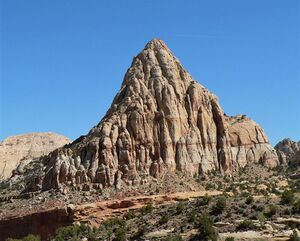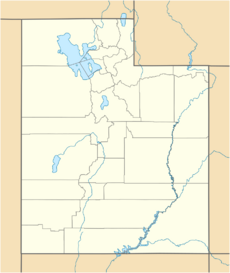Earth:Pectols Pyramid
| Pectols Pyramid | |
|---|---|
 Northwest aspect | |
| Highest point | |
| Elevation | 6,211 ft (1,893 m) [1] |
| Prominence | 407 ft (124 m) [2] |
| Isolation | 0.91 mi (1.46 km) [2] |
| Coordinates | [ ⚑ ] : 38°17′07″N 111°13′36″W / 38.2851567°N 111.2266007°W [1] |
| Geography | |
| Location | Capitol Reef National Park Wayne County, Utah, United States |
| Parent range | Colorado Plateau |
| Topo map | USGS Fruita |
| Geology | |
| Age of rock | Jurassic |
| Type of rock | Navajo Sandstone |
Pectols Pyramid is a 6,211-foot (1,893-meter) elevation summit located in Capitol Reef National Park, in Wayne County of Utah, United States. This iconic landmark is situated 2 mi (3.2 km) southeast of the park's visitor center, 1 mi (1.6 km) south of Navajo Dome, and 0.5 mi (0.80 km) southwest of Capitol Dome. Precipitation runoff from this feature is drained by the Fremont River, which in turn is within the Colorado River drainage basin. This geological feature's name honors Ephraim Portman Pectol (1875–1947), booster and founder of what would become Capitol Reef National Monument in 1937.[3]
Geology
Pectols Pyramid is composed of Navajo Sandstone, which is believed to have formed about 180 million years ago as a giant sand sea, the largest in Earth's history.[4] In a hot, dry climate, wind blew over sand dunes, creating large, sweeping crossbeds which date to the Jurassic. Long after the sedimentary rocks were deposited, the Colorado Plateau was uplifted relatively evenly, keeping the layers roughly horizontal, but Capitol Reef is an exception because of the Waterpocket Fold, a classic monocline, which formed between 50 and 70 million years ago during the Laramide Orogeny.[5]
Gallery
Climate
Spring and fall are the most favorable seasons to visit Pectols Pyramid. According to the Köppen climate classification system, it is located in a Cold semi-arid climate zone, which is defined by the coldest month having an average mean temperature below 32 °F (0 °C), and at least 50% of the total annual precipitation being received during the spring and summer. This desert climate receives less than 10 inches (250 millimeters) of annual rainfall, and snowfall is generally light during the winter. Script error: No such module "weather box".
See also
References
- ↑ 1.0 1.1 U.S. Geological Survey Geographic Names Information System: Pectols Pyramid
- ↑ 2.0 2.1 "Pectols Pyramid, Utah". http://www.peakbagger.com/peak.aspx?pid=96716.
- ↑ Park Founders NPS.gov
- ↑ Capitol Reef National Park, National Park Service
- ↑ Capitol Reef Geology, NPS.gov
- ↑ "PRISM Climate Group, Oregon State University". http://prism.oregonstate.edu/explorer/.
External links
- Capitol Reef National Park National Park Service
- Ephraim P. Pectol: Entradainstitute.org
 |










